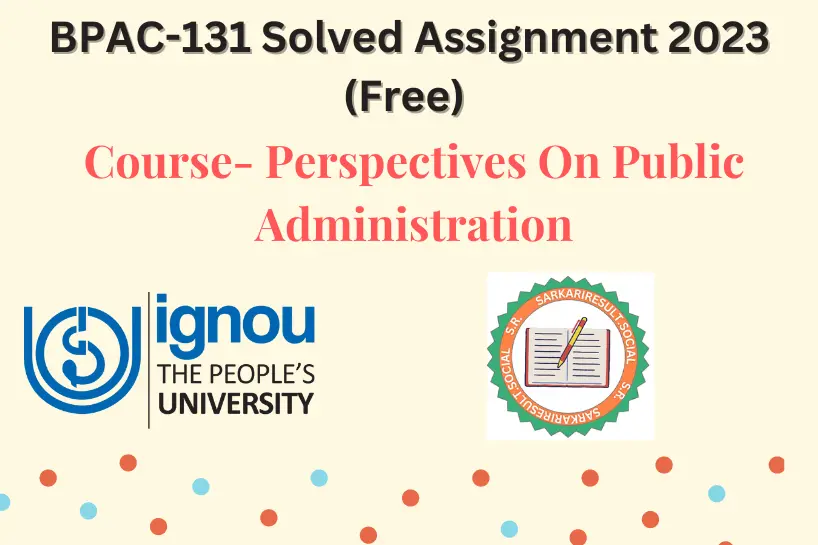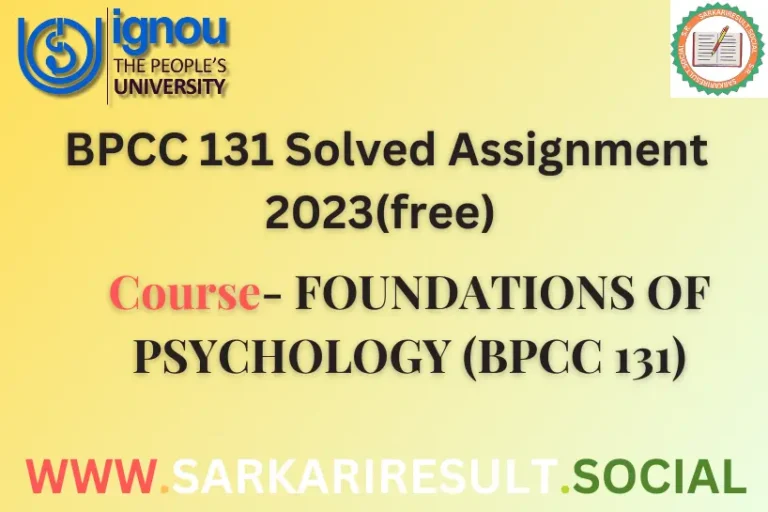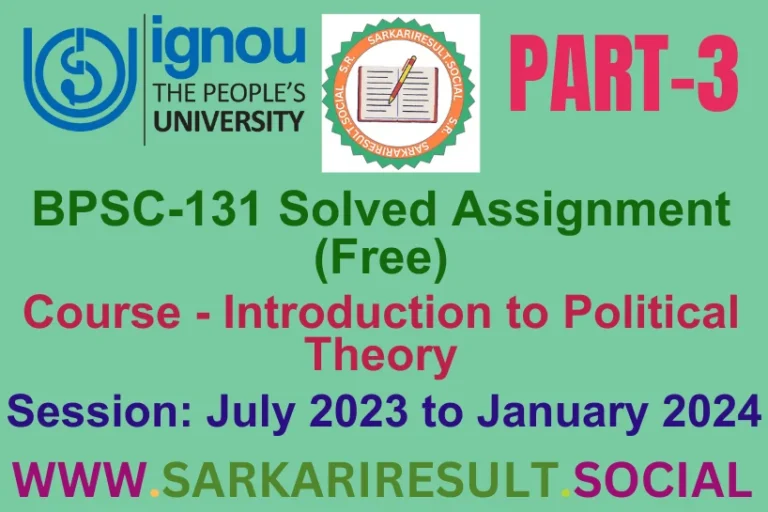Check BPAC-131 Solved Assignment 2023 (Free) before LAST DATE

BPAC-131 IGNOU Solved Assignment 2023 (Free)
BPAC 131 is a course offered by the IGNOU as a part of their Bachelor’s degree program in Public Administration. This course aims to provide students with an understanding of the various components of public administration, including administrative structure, policies, functions, and challenges faced by public administrators.
It also highlights the importance of public administration in promoting efficient and effective governance at different levels of government, including national, state, and local.
As part of your course requirements, you may need to write IGNOU Assignments related to the course content. Don’t worry – we’ve got you covered! In this article, we’ll provide you with IGNOU Solved Assignment of BPAC 131.”
Questions and Answers (Solved)
Assignment A
Q.1 Discuss the principles and characteristics of Scientific Management.
Ans. Scientific Management is an approach to management that emphasizes the use of scientific methods to improve efficiency and productivity in the workplace. It was developed by Frederick Winslow Taylor in the late 19th and early 20th centuries and has since become an influential management theory.
Principles of Scientific Management:
1. Scientific study of work: The first principle of Scientific Management is the scientific study of work. This involves breaking down tasks into smaller parts and analyzing them to identify the most efficient way of performing each task.
2. Time and motion study: The second principle of Scientific Management is the time and motion study. This involves measuring the time required to perform each task and identifying the most efficient way of performing it.
3. Standardization of work: The third principle of Scientific Management is the standardization of work. This involves developing standardized procedures and tools for performing each task to ensure consistency and efficiency.
4. Division of labor: The fourth principle of Scientific Management is the division of labor. This involves dividing tasks among workers based on their skills and abilities to increase efficiency and productivity.
5. Scientific selection and training of workers: The fifth principle of Scientific Management is the scientific selection and training of workers. This involves selecting workers based on their abilities and providing them with the necessary training and tools to perform their tasks efficiently.
Characteristics of Scientific Management:
1. Efficiency: The first characteristic of Scientific Management is efficiency. It aims to increase efficiency and productivity by identifying the most efficient way of performing tasks and implementing standardized procedures and tools.
2. Specialization: The second characteristic of Scientific Management is specialization. It involves dividing tasks among workers based on their skills and abilities to increase efficiency and productivity.
3. Standardization: The third characteristic of Scientific Management is standardization. It involves developing standardized procedures and tools for performing tasks to ensure consistency and efficiency.
4. Control: The fourth characteristic of Scientific Management is control. It involves closely monitoring and controlling the work of employees to ensure that they are performing their tasks efficiently and effectively.
5. Emphasis on results: The fifth characteristic of Scientific Management is emphasis on results. It focuses on achieving specific results and objectives through the use of scientific methods and tools.
In conclusion, Scientific Management is an approach to management that emphasizes the use of scientific methods to improve efficiency and productivity in the workplace. It is based on principles such as the scientific study of work, time and motion study, standardization of work, division of labor, and scientific selection and training of workers. Its characteristics include efficiency, specialization, standardization, control, and emphasis on results. By implementing these principles and characteristics, organizations can increase their efficiency and productivity and achieve their goals more effectively.

Q.2 Write a note on postmodern trends in Public Administration.
Ans. Postmodernism is a school of thought that emerged in the mid-20th century as a response to modernism. It refers to a diverse range of social, cultural, and intellectual movements that challenge the concepts of absolute truth, objective reality, and universal values.
Postmodern trends in public administration emerged in the late 20th century, and they have had a significant impact on the field. This note will discuss the postmodern trends in public administration.
One of the key features of postmodernism is its emphasis on the subjective and relative nature of truth. This perspective challenges the traditional, modernist view of public administration, which emphasizes objective, scientific methods and the pursuit of efficiency and rationality.
Postmodernism argues that knowledge is socially constructed and context-specific, and that different perspectives can produce different truths.
Another characteristic of postmodernism is its emphasis on the importance of language and discourse. Postmodernists argue that language is not simply a neutral tool for communication, but is rather a powerful instrument that shapes the way we understand and interpret the world. This perspective challenges the modernist view of public administration, which assumes that language is transparent and that there is a clear, unambiguous meaning to words.
Postmodernism also challenges the traditional view of bureaucracy and hierarchical organizations. Postmodernists argue that bureaucratic structures are inherently oppressive and hierarchical, and that they are ill-suited to the complex and dynamic challenges of the modern world. Instead, they propose more flexible, network-based structures that are better able to respond to changing circumstances and to engage with diverse stakeholders.
Postmodernism also places a greater emphasis on the role of culture and identity in public administration. Postmodernists argue that different cultural and identity groups have different values, priorities, and perspectives, and that these differences need to be recognized and accommodated in public administration.
This perspective challenges the modernist view of public administration, which assumes that there is a single, universal set of values and priorities that can be applied to all situations.
Postmodernism has also had an impact on public policy. Postmodernists argue that policy is not simply a technical exercise, but rather a political and cultural one.
They emphasize the importance of stakeholder participation, dialogue, and negotiation in policy development, and they challenge the traditional view that policy should be based solely on objective, scientific analysis.
In conclusion, postmodern trends in public administration have had a significant impact on the field, challenging many of the assumptions and practices of traditional, modernist approaches.
Postmodernism emphasizes the subjective and relative nature of truth, the importance of language and discourse, the need for more flexible and network-based structures, the role of culture and identity, and the importance of stakeholder participation and dialogue in policy development.
These trends have led to new approaches to public administration that are more inclusive, responsive, and adaptable to the complex and dynamic challenges of the modern world.
Assignment B
Q.3 Briefly discuss the Henry Fayol’s views on Administrative Management Approach.
Ans. Henry Fayol was a French management theorist who developed the Administrative Management Approach in the early 20th century. He believed that the success of an organization depends on the effectiveness of its management and proposed fourteen principles of management that are still relevant today.
Fayol believed that management is a distinct activity that can be studied and improved upon, and he focused on the following principles:
1. Division of Work: This involves dividing the work into smaller tasks and assigning them to individuals based on their specialization and skill set.
2. Authority: Managers must have the authority to give orders and enforce obedience.
3. Discipline: Employees must respect the rules and regulations of the organization.
4. Unity of Command: Each employee must have only one boss to report to.
5. Unity of Direction: The organization must have a single plan and objective.
6. Subordination of Individual Interest: The interest of the organization must come before the individual interest of the employees.
7. Remuneration: Employees must be paid fairly and the compensation system must be designed to motivate them to work harder.
8. Centralization: Decision-making power should be centralized at the top level of management.
9. Scalar Chain: The organization should have a clear hierarchy of authority.
10. Order: There should be a place for everything and everything should be in its place.
11. Equity: Employees should be treated with fairness and justice.
12. Stability of Tenure: Employee turnover should be minimized to maintain stability and continuity.
13. Initiative: Employees should be encouraged to take initiative and contribute their ideas.
14. Esprit de Corps: There should be a sense of unity and team spirit among the employees.
Fayol’s Administrative Management Approach emphasized the importance of organizational structure and the role of managers in the success of an organization. His principles are still used today to manage organizations and improve productivity.

Q.4 Describe an appraise of Human Relations Approach.
Ans. The Human Relations Approach is an important concept in the field of management, which emerged in the early 20th century as a reaction to the classical approach to management.
The approach emphasizes on the importance of social factors in organizations and believes that employees are not just mere factors of production, but also have social and psychological needs.
The Human Relations Approach, also known as the behavioral approach, was first introduced by Elton Mayo and his colleagues in the Hawthorne Studies conducted between 1924 and 1932. The study aimed to determine how changes in work environment and lighting conditions affect worker productivity.
Surprisingly, the study found that the productivity of workers increased, not because of changes in the work environment, but due to the social relationships among workers and between workers and management.
The Human Relations Approach is based on the following principles:
1. Social beings: Employees are social beings who have social and psychological needs that must be met for them to be productive.
2. Informal groups: Informal groups exist within organizations, and their influence on employee behavior should not be ignored.
3. Communication: Effective communication is critical for organizational success, and it is important to create an open and honest communication environment.
4. Leadership: Good leadership is essential for motivating employees and improving productivity.
5. Motivation: Employee motivation can be improved by recognizing and satisfying their needs.
6. Participation: Employees should be allowed to participate in decision-making processes that affect them.
The Human Relations Approach also emphasizes on the following characteristics:
1. Employee-centered approach: The approach places emphasis on the needs of employees and seeks to improve their working conditions.
2. Importance of communication: Communication is considered a vital component of organizational success.
3. Recognition of informal groups: Informal groups are recognized and given importance in the organization.
4. Emphasis on leadership and motivation: Good leadership and motivation are critical for organizational success.
In conclusion, the Human Relations Approach has contributed greatly to the study of management by emphasizing on the importance of social factors in organizations. The approach recognizes the importance of employees as social beings and their needs for social and psychological fulfillment.
It stresses on the importance of effective communication, good leadership, and employee participation for improving organizational performance.
Q.5 Discuss the conceptual framework of New Public Management.
Ans. New Public Management (NPM) is a conceptual framework that emphasizes the use of private sector management techniques in public sector organizations. It emerged in the 1980s as a response to criticisms of traditional public administration and a desire for more efficient and effective government services.
The main features of NPM are as follows:
1. Decentralization: NPM emphasizes decentralization of decision-making, with greater responsibility given to lower levels of government or to private organizations.
2. Performance measurement: NPM advocates the use of performance measurement tools to evaluate the effectiveness and efficiency of government programs.
3. Results-based management: NPM emphasizes the need for public sector organizations to focus on achieving results rather than simply following rules and procedures.
4. Contracting out: NPM advocates the use of contracting out or outsourcing as a way of delivering public services more efficiently.
5. Customer focus: NPM emphasizes the need for public sector organizations to focus on the needs of their customers, with a view to improving the quality of services.
6. Managerialism: NPM is characterized by a managerialist approach, with an emphasis on professional management practices and techniques.
7. Entrepreneurialism: NPM encourages public sector organizations to adopt an entrepreneurial approach, with a focus on innovation and risk-taking.
In summary, NPM is a conceptual framework that seeks to apply private sector management techniques in the public sector. It emphasizes decentralization, performance measurement, results-based management, contracting out, customer focus, managerialism, and entrepreneurialism.
Q.6 What is the difference Programmed and Non-Programmed Decisions?
Ans. Programmed decisions are the decisions that are repetitive and follow a pre-defined set of procedures. These decisions are based on a structured approach and are usually taken for routine tasks.
For instance, a manager making a decision to order office supplies every month can be considered a programmed decision.
On the other hand, non-programmed decisions are unique and require a customised approach. These decisions do not follow any pre-defined set of procedures and are often taken in response to unforeseen situations.
For example, a manager making a decision on how to handle a crisis situation or how to respond to a new competitor in the market can be considered a non-programmed decision. Non-programmed decisions require creativity, intuition, and judgment to resolve complex problems.

Q.7 What do you mean by Organisational Equilibrium?
Ans. Organizational Equilibrium refers to a state of balance in an organization, where the internal and external factors affecting the organization are in a state of stability and harmony.
It is achieved when the organization’s goals and objectives are aligned with its resources, capabilities, and external environment, and the organization is operating efficiently. In an equilibrium state, the organization can maintain its position and continue to function effectively.
However, any significant changes in the internal or external environment can disrupt this equilibrium, and the organization must adjust its strategies and operations accordingly to maintain balance. Organizational Equilibrium is important for the long-term sustainability and success of the organization.
Also see : BEVAE-181 IGNOU Solved Assignment 2023 (Free)
Q.8 Write a short on Easton’s Views on Public Policy Approach.
Ans. David Easton’s Views on Public Policy Approach emphasizes that public policies should be formulated to address the society’s issues and problems.
He believed that public policies are a product of the political system and the society, and they reflect the values and beliefs of the society. Easton also emphasized the importance of feedback in public policy-making, where the impact of policies is evaluated and used to modify and improve them.
In his approach, Easton also recognized the role of power and conflict in shaping public policies, where different interest groups and stakeholders compete for influence and resources.
Q.9 Define the term Governance and Good Governance.
Ans. Governance refers to the way in which power is exercised to manage the affairs of a country or an organization. It involves the process of decision-making and the implementation of policies and laws.
Good Governance, on the other hand, refers to the principles and practices that ensure effective, efficient, transparent, and accountable management of public affairs. It includes the rule of law, participation of citizens in decision-making, responsiveness, equity, and inclusiveness.
Good Governance aims to promote social and economic development, reduce poverty, and ensure the protection of human rights. It also ensures that the government is accountable to its citizens and operates in their best interests.
Q.10 Differentiate between ‘gender of governance’ and ‘governance of gender’.
Ans. The term “gender of governance” refers to the gender-based biases that are built into the structures and practices of governance. This includes gender stereotypes, unequal power relations, and the marginalization of women and other gender minorities.
On the other hand, “governance of gender” refers to policies and practices that aim to address gender inequality and promote gender justice in governance. This involves ensuring equal representation and participation of women and gender minorities in decision-making, implementing gender-sensitive policies, and addressing gender-based violence and discrimination.
In essence, the former refers to the existing gender biases in governance, while the latter refers to efforts to promote gender equality and justice in governance.







